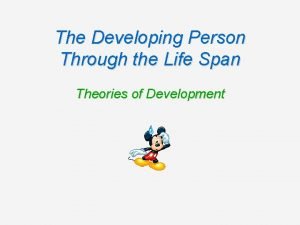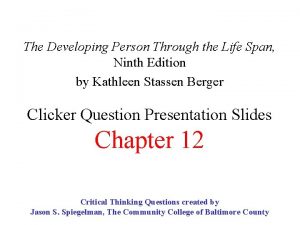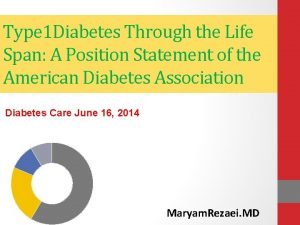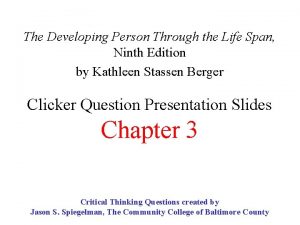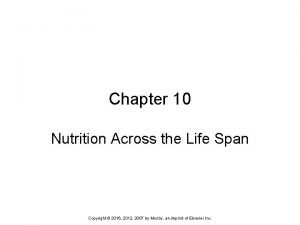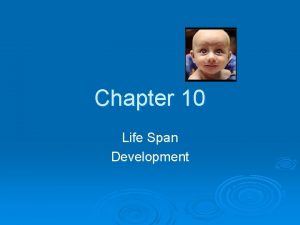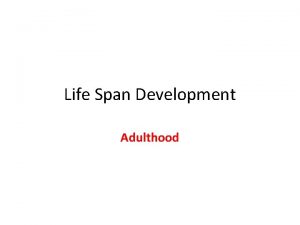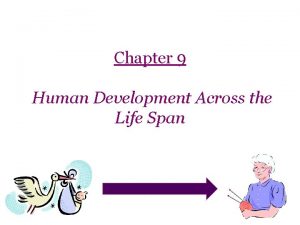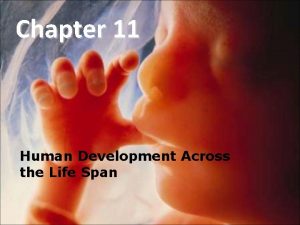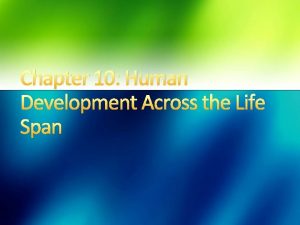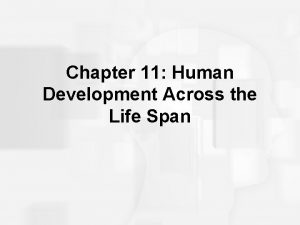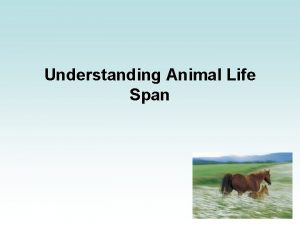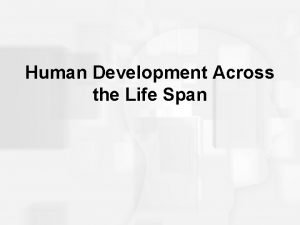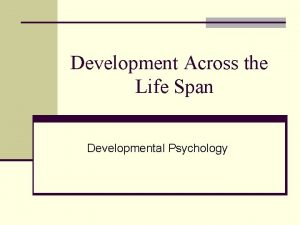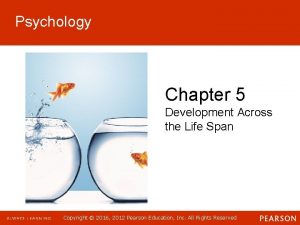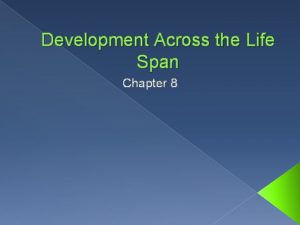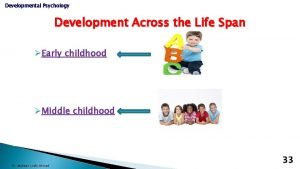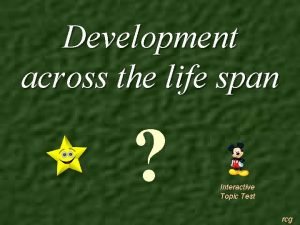Chapter 11 Human Development Across the Life Span



































- Slides: 35

Chapter 11 Human Development Across the Life Span – 8 th Edition

Progress Before Birth: Prenatal Development n 3 phases – germinal stage = first 2 weeks • conception, implantation, formation of placenta – embryonic stage = 2 weeks – 2 months • formation of vital organs and systems – fetal stage = 2 months – birth • bodily growth continues, movement capability begins, brain cells multiply • age of viability Table of Contents

Table of Contents

Environmental Factors and Prenatal Development Figure 11. 2, p. 443 – periods of vulnerability in prenatal period n Maternal nutrition n – Malnutrition linked to increased risk of birth complications, neurological problems, and psychopathology n Maternal drug use – Tobacco, alcohol, prescription, and recreational drugs – Fetal alcohol syndrome n Maternal illness – Rubella, syphilis, mumps, genital herpes, AIDS, severe influenza – Prenatal health care – Prevention through guidance n n Infant mortality by countries – Slide 5 Preventive care for children Table of Contents

Slide 5 Cross-cultural comparisons of infant mortality Table of Contents

The Childhood Years: Motor Development n Basic Principles – Cephalocaudal trend – head to foot – Proximodistal trend – center-outward Maturation – gradual unfolding of genetic blueprint n Developmental norms – Figure 11. 3 n – median age – growth charts – 95% level – Cultural variations Table of Contents

Figure 11. 3 – Developmental Motor milestones Table of Contents

Easy and Difficult Babies: Differences in Temperament Longitudinal vs. cross-sectional designs – 11. 4 n Thomas, Chess, and Birch (1970) n Figure – 3 basic temperamental styles • • easy – 40% slow-to-warm-up – 15% difficult – 10% mixed – 35% – stable over time n Kagan & Snidman (1991) – Inhibited vs. uninhibited temperament • inhibited – 15 - 20% • uninhibited – 25 - 30% – stable over time, genetically based Table of Contents

XX 11. 4 Table of Contents

Early Emotional Development: Attachment n Separation anxiety – Ainsworth (1979) – The strange situation and patterns of attachment • • Secure Anxious-ambivalent Avoidant Figure 11. 5, process and Figure 11. 6, cross-cultural comparison • Effects on mating strategy – slide 11 n Developing secure attachment – Bonding at birth – contact comfort – Harlow – p. 449 – Daycare – Cultural factors n Evolutionary perspectives on attachment Table of Contents

Figure 11 -6 – Cultural variations in attachment patterns Slide 11 - Attachment and mating strategy, from childhood to puberty Table of Contents

Stage Theories of Development: Personality n Stage theories, three components – progress through stages in order – progress through stages related to age – major discontinuities in development - Figure 11. 7 n Erikson (1963) – Figure 11. 8 – Eight stages spanning the lifespan – Psychosocial crises determining balance between opposing polarities in personality Table of Contents

XX 11. 7 Table of Contents

XX 11. 8 Table of Contents

Stage Theories: Cognitive Development n Jean Piaget (1920 s-1980 s) – Assimilation/ Accommodation – 4 stages and major milestones – Figure 11. 9 • Sensorimotor – Object permanence • Preoperational – Centration, Egocentrism • Concrete Operational – Decentration, Reversibility, Conservation – F 11. 10, F 11. 11 • Formal Operational – Abstraction Table of Contents

XX 11. 9 Table of Contents

XX 11. 10 Table of Contents

XX 11. 11 Table of Contents

Other Cognitive Abilities n Vygotsky’s Sociocultural Theory – Thought and Language (1934) – Importance of social interactions in cognitive development – Zone of proximal development (ZPD) – difference in accomplishing alone and with help from others Inhibition – disinhibition – innate? n Memory abilities – active maintenance rehearsal 910 years n Memory capacities - metacognition n Table of Contents

The Development of Moral Reasoning n Kohlberg (1976) – Reasoning as opposed to behavior • Moral dilemmas – Measured nature and progression of moral reasoning – 3 levels, each with 2 sublevels – Figure 11. 14 • Preconventional – punishment S 1 – naïve reward S 2 • Conventional - good boy/good girl S 3 – authority S 4 • Postconventional - social contract S 5 – individual principles and conscience S 6 – Longitudinal studies – F 11. 15 , research issues (use of males), reasoning versus behavior n Greene’s et al. studies of moral judgments and brain functioning – f. MRI studies using 60 moral dilemmas Table of Contents

XX 11. 14 Figure 11. 15 – Age and moral reasoning based on Kohlberg’s stages Table of Contents

Adolescence: Puberty and the Growth Spurt n Pubescence – growth spurts 10 – 12 females n 12 – 14 males Puberty – Secondary sex characteristics – Primary sex characteristics • Menarche • Sperm production • Tanner stages – Maturation: early vs. late – Belsky’s study • Sex differences in effects of early maturation n Brain Development in adolescence – Figure 11. 17 http: //serendip. brynmawr. edu/bb/neuro 04/web 1/epow ell. html n Risk taking – F 11. 18 n Rates of suicide – F 11. 17 n Table of Contents

Figure 11. 16 Physical development at puberty Table of Contents

Figure 11. 17 – Prefrontal Cortex and adolescence development Table of Contents

Figure 11. 18 Peer influence on risk taking Table of Contents

The Search for Identity Problems – suicide rates and brain development n Erikson (1968) n – Key challenge - forming a sense of identity n James Marcia (1988) – Figure 11. 20 – 4 identity statuses • • n Foreclosure Moratorium Identity Diffusion Identity Achievement Longitudinal study – changes in the four statuses – slide 28 Table of Contents

Figure 11. 20 Marcia’s four identity statuses Table of Contents

Slide 28 – Age and Identity status based on Marcia (1980), data from Meilman (1979) Table of Contents

Emerging Adulthood as a New Developmental Stage Search for identity extends into adulthood n Figure 11. 21 n Ages 18 – 25 have become a distinct transitional stage of life n Characterized by: n – – subjective feeling of transition age of possibilities self-focused period of identity formation Table of Contents

The Expanse of Adulthood Personality development – midlife crisis? - F 11. 11 n Social development – family life cycle, marriage, parenthood, empty nest – Figure 11. 23 n Career development – patterns, work and in the home – Figure 11. 24 n Physical changes – biological aging process n n Cognitive changes – mental abilities - Figure 11. 25 memory, response time - Figure 11. 26 Table of Contents

Figure 11. 23 – Median age at first marriage in United States Table of Contents

Figure 11. 24 – Housework trends since the 1960 s Table of Contents

Figure 11. 25 Age and the stability of primary mental abilities Table of Contents

Gender Differences and issues n n n n Stereotypes – Table 11. 1 Cognitive – Figure 11. 27 Social/personality Biological origins – brain hemisphere differences – Figure 11. 28 Hormone influences – estrogens androgens Environment influences - socialization Gender role – gender versus sex Father’s role in children’s well-being – issues – pages 484 - 485 Table of Contents

Figure 11. 27 – distribution of gender differences Figure 11. 28 – The cerebral hemispheres and the corpus callosum Table of Contents
 Chapter 7 life span development
Chapter 7 life span development Human needs and human development chapter 8
Human needs and human development chapter 8 Chapter 8 human needs and human development
Chapter 8 human needs and human development Stages of painted lady chrysalis
Stages of painted lady chrysalis Immortal jellyfish phylum
Immortal jellyfish phylum Life span of eagle
Life span of eagle Life span theories
Life span theories Carly is given grapes and strawberries
Carly is given grapes and strawberries Honey bee lifespan
Honey bee lifespan Petit four sec
Petit four sec Project life span
Project life span The developing person through the life span 9th edition
The developing person through the life span 9th edition Ozymandias explanation with quotations
Ozymandias explanation with quotations Life span type 1 diabetes
Life span type 1 diabetes The developing person through the life span 9th edition
The developing person through the life span 9th edition Human development index definition ap human geography
Human development index definition ap human geography Pqli advantages and disadvantages
Pqli advantages and disadvantages Genetic effects on gene expression across human tissues
Genetic effects on gene expression across human tissues Organizational patterns in reading
Organizational patterns in reading Nutrition across life stages
Nutrition across life stages Chapter 5 diversity and human needs and development
Chapter 5 diversity and human needs and development Chapter 36 section 2 human development before birth
Chapter 36 section 2 human development before birth Infancy psychosocial development
Infancy psychosocial development Hình ảnh bộ gõ cơ thể búng tay
Hình ảnh bộ gõ cơ thể búng tay Slidetodoc
Slidetodoc Bổ thể
Bổ thể Tỉ lệ cơ thể trẻ em
Tỉ lệ cơ thể trẻ em Gấu đi như thế nào
Gấu đi như thế nào Chụp tư thế worms-breton
Chụp tư thế worms-breton Hát lên người ơi
Hát lên người ơi Môn thể thao bắt đầu bằng chữ đua
Môn thể thao bắt đầu bằng chữ đua Thế nào là hệ số cao nhất
Thế nào là hệ số cao nhất Các châu lục và đại dương trên thế giới
Các châu lục và đại dương trên thế giới Công thức tính độ biến thiên đông lượng
Công thức tính độ biến thiên đông lượng Trời xanh đây là của chúng ta thể thơ
Trời xanh đây là của chúng ta thể thơ Mật thư tọa độ 5x5
Mật thư tọa độ 5x5






